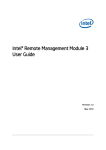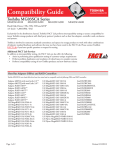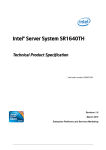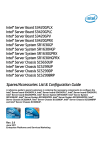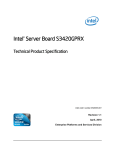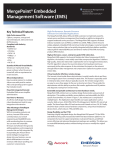Download Intel AXXRMM3 remote management adapter
Transcript
Intel® Remote Management Module 3 Technical Product Specification Intel order number E63789-002 Revision 1.1 May, 2010 Enterprise Platforms and Services Division – Marketing Revision History Intel® Remote Management Module 3 Revision History Date March, 2009 Revision Number 1.0 Modifications Initial release May, 2010 1.1 Updated RMM3 Lite and RMM3 Lite-V Disclaimers ® Information in this document is provided in connection with Intel products. No license, express or implied, by estoppel or otherwise, to any intellectual property rights is granted by this document. Except as provided in Intel's Terms and Conditions of Sale for such products, Intel assumes no liability whatsoever, and Intel disclaims any express or implied warranty, relating to sale and/or use of Intel products including liability or warranties relating to fitness for a particular purpose, merchantability, or infringement of any patent, copyright or other intellectual property right. Intel products are not intended for use in medical, life saving, or life sustaining applications. Intel may make changes to specifications and product descriptions at any time, without notice. Designers must not rely on the absence or characteristics of any features or instructions marked "reserved" or "undefined." Intel reserves these for future definition and shall have no responsibility whatsoever for conflicts or incompatibilities arising from future changes to them. The Intel® Remote Management Module 3 may contain design defects or errors known as errata which may cause the product to deviate from published specifications. Current characterized errata are available on request. Intel, Pentium, Itanium, and Xeon are trademarks or registered trademarks of Intel Corporation. *Other brands and names may be claimed as the property of others. Copyright © Intel Corporation 2010. All rights reserved. ii Intel order number E63789-002 Revision 1.1 Intel® Remote Management Module 3 Table of Contents Table of Contents 1. Introduction .......................................................................................................................... 1 2. Product Overview ................................................................................................................. 2 2.1 Virtual Presence ....................................................................................................... 2 2.2 Firmware Feature Set .............................................................................................. 2 2.3 Web Front-end ......................................................................................................... 3 2.4 Virtual Media ............................................................................................................ 3 2.5 Remote Console ...................................................................................................... 4 2.6 Hardware Feature Set .............................................................................................. 4 2.6.1 2.7 3. 4. Physical Dimensions ................................................................................................ 6 Board Architecture ............................................................................................................. 10 3.1 USB 2.0 (high-speed) Interface .............................................................................. 10 3.2 RMII Interface ........................................................................................................ 11 3.3 64-MB SDRAM System Memory ........................................................................... 11 3.4 8-MB Flash ............................................................................................................ 11 Electrical Specifications .................................................................................................... 12 4.1 3.3 V Auxiliary Operation ....................................................................................... 12 4.2 DC Specifications .................................................................................................. 12 4.2.1 4.3 5. Functionality............................................................................................................. 4 Supported Video Resolutions and Refresh Rates .................................................. 12 System Reset Control ............................................................................................ 14 Network Connections and Authentication ....................................................................... 15 5.1 5.1.1 Network Connectivity ............................................................................................. 15 Supported Traffic ................................................................................................... 15 Glossary..................................................................................................................................... 16 Revision 1.1 Intel order number E63789-002 iii List of Tables Intel® Remote Management Module 3 List of Tables Table 1. RMM3 Connector Pin-out ............................................................................................... 5 Table 2. Supported Video Resolutions and Refresh Rates ........................................................ 12 iv Intel order number E63789-002 Revision 1.1 Intel® Remote Management Module 3 1. Introduction Introduction This Technical Product Specification (TPS) provides details about the architecture and feature set of the Intel® Remote Management Module 3 (Intel® RMM3),and its two variations - Intel® Remote Management Module 3 Lite (Intel® RMM3 Lite) and Intel® Remote Management Module 3 Lite-v (Intel® RMM3 Lite-v) . This document does not replace the Intel® RMM3 User’s Guide, but provides enhanced information to assist with understanding and learning more about specific features of the board. Revision 1.1 Intel order number E63789-002 1 Product Overview 2. Intel® Remote Management Module 3 Product Overview The Intel® RMM3 is a 1.23-inch x 2.30-inch printed circuit board. When installed onto the Intel® RMM connector on Intel® server boards, it provides an increased level of manageability over basic server management available to the server board. Designed to work with the Integrated Baseboard Management Controller (BMC), this small form-factor mezzanine card enables graphical server control from anywhere, at anytime. RMM3 has two variations – RMM3 Lite and RMM3 Lite-V, which have the same functionality as RMM3. RMM3 Lite currently only can be used on Intel® S3420GPRX, it has not RMM3dedicated NIC. The management traffic only can go through onboard Integrated BMC-shared NIC (NIC5 on Intel® S3420GPRX) and share network bandwidth with the host system. RMM3 Lite-V module currently only can be used on Intel® SR1640TH server system, its RMM3dedicated NIC is separated and integrated on server board. 2.1 Virtual Presence The Intel® RMM3 provides Virtual Presence (Remote Console) at the host server. This presence includes keyboard / video / mouse (KVM) redirection over Transmission Control Protocol/Internet Protocol (TCP/IP) using an Ethernet network port dedicated for remote management. The keyboard, video, and mouse of the remote server are available to the administrator from any network location, regardless of the state of the server (OS loading, running, or not responding (blue screen), Pre-OS BIOS boot and setup, etc). The dedicated Ethernet controller supports Out-Of-Band (OOB) access. In other words, it runs separately from the OS and the BIOS. This separation allows the Intel® RMM3 to operate continuously, thus supporting 24 X 7 management of the system. The management traffic does not share network bandwidth with the host system software. 2.2 2 Firmware Feature Set Intel® RMM3 Virtual Presence over remote console: Keyboard/Video/Mouse (KVM) redirection over TCP/IP Intel® RMM3 web server supporting HTTPS or HTTP Automatically senses video resolution for best possible screen display Intel® RMM3 Virtual Media: USB remote storage redirection over TCP/IP, supports one floppy drive or USB flash drive, and one CD/DVD drive at a time Intel® RMM3 Virtual Presence over Web Front-end: Power and Reset Control over TCP/IP Interaction with the Integrated BMC for support of Intelligent Platform Management Interface (IPMI) 2.0 Support for a dedicated 10/100 Out-Of-Band (OOB) Management LAN channel Local Configuration Utilities for Microsoft Windows* and Linux Intel order number E63789-002 Revision 1.1 Intel® Remote Management Module 3 2.3 Product Overview Highest security standards using up to 256-bit SSLv3, Certificate Management, Event Logging, and State-of-the-Art authentication methods Web Front-end The Intel® RMM3 module features an embedded operating system and application offering a variety of standard interfaces. These interfaces are accessed using the TCP/IP protocol family, and therefore, they can be accessed using the built-in Ethernet adapter. The Intel® RMM3 Web Front-end is a Graphical User Interface (GUI). It offers convenient and secure access to Open the Remote Console Virtual Media System Health User Management KVM Settings RMM3/BMC network settings System information Using a standard web browser on the administrator’s client computer, the Intel® RMM3 Web GUI provides Virtual Presence to the server. It offers the user the ability to: Obtain detailed system information Perform virtual media transfers Control power and reset the server In addition, the Intel® RMM3 allows the user to open a Remote console, see the screen of the target system and work with all applications as if he/she was seated at the system. All network communication with the Intel® RMM3 is secured using industry-standard authentication, encryption, and access control mechanisms. Access to the Intel® RMM3 Web Console is controlled by a user-based security system. 2.4 Virtual Media The Intel® RMM3 provides Virtual Media, which is USB remote storage redirection over TCP/IP, using the dedicated LAN interface. Administrators use Intel® RMM3 Virtual Media to: Upload a floppy image to the Intel® RMM3, maximum size of 1.44 MB. Mount a CD-ROM / DVD-ROM ISO image from the client computer or from a network share. Redirect Floppy, CD-ROM / DVD-ROM drives or USB flash drives that are physically local to the administrator’s client computer, to appear as a USB mass storage device on the target server. Revision 1.1 Intel order number E63789-002 3 Product Overview Intel® Remote Management Module 3 Once mounted, the media that is remote to the server appears local to the server. This allows administrators to install software or drivers on the server, or boot the server from the remote media. Intel® RMM3 - Virtual Media can be used to complete the following actions: Install a new operating system on a target server Perform an operating system upgrade on a target server Repair damaged operating system installs Transfer files to and from the target server to a remote location The Intel® RMM3 Virtual Media offers to redirect two drives at a time, which makes it even more comfortable to perform remote OS installations and allows access to use additional driver disks during OS installation. One CD/DVD device, and one floppy device or USB flash drive are supported simultaneously. It is not advisable to update the Integrated BMC firmware or RMM3 firmware via the RMM3 interface. 2.5 Remote Console The Remote Console is the redirected screen, keyboard, and mouse of the remote host system where the Intel® RMM3 module is installed. To use the Remote Console window of your managed host system, the browser must include a Java Runtime Environment plug-in. If the browser has no Java support, such as with a small handheld device, the user can maintain the remote host system using the administration forms displayed by the browser. Refer to the Intel® RMM3 User’s Guide for specific Java version information. The Remote Console window is a Java applet that establishes its own TCP connection to the Intel® RMM3 module. Starting the Remote Console opens a new window to display the screen content of the host system. The Remote Console acts as if the administrator was sitting directly in front of the screen of his/her remote system. This means the keyboard and mouse can be used in the usual way. 2.6 Hardware Feature Set 2.6.1 Functionality Intel® RMM3 utilizes the on-board ServerEngines* Pilot II Baseboard Management Controller, which is an ARM9 controller with the following features: 4 250 MHz 32-bit ARM9 Processor Memory Management Unit (MMU) Two 10/100 Ethernet Controllers with NC-SI USB 2.0 for Keyboard, Mouse, and Storage devices USB 1.1 interface for legacy PS/2 to USB bridging Intel order number E63789-002 Revision 1.1 Intel® Remote Management Module 3 Product Overview Hardware Video Compression for text and graphics Hardware encryption 2D Graphics Acceleration DDR2 graphics memory interface Up to 1600x1200 pixel resolution PCI Express* x1 support The Intel® RMM3 connects to the Intel® RMM connector on the Intel® server board via the iPN D16503-004, Amphenol G845B034211, or equivalent connector on the server board. Table 1. RMM3 Connector Pin-out Pin 1 3 5 7 9 11 13 15 17 19 21 23 25 27 29 31 33 Name Pin 2 4 6 8 10 12 14 16 18 20 22 24 26 28 30 32 34 3V3_AUX 3V3_AUX GND GND GND GND GND GND GND GND GND 3V3_AUX 3V3_AUX 3V3_AUX GND GND GND Name SMI_MDIO SMI_MDC RMII_RXD1 RMII_RXD0 RMII_RX_DV RMII_REF_CLK RMII_RX_ER RMII_TX_EN KEY (pin removed) RMII_TXD0 RMII_TXD1 SPI_CS_N NC (spare) SPI_DO SPI_CLK SPI_DI RMM3_Present_N Table 2. RMM3 Lite Connector Pin-out Pin Signal Name Pin 2 Signal Name SPI_IBMC_BK_CS_N 1 P3V3 3 FM_RMM3_PRESENT_N 4 RMII_IBMC_RMM3_MDIO 5 GND 6 SPI_IBMC_BK_CLK 7 KEY 8 SPI_IBMC_BK_DI Table 3. RMM3 Lite-V Connector Pin-out Pin Revision 1.1 Signal Name Pin Intel order number E63789-002 Signal Name 5 Product Overview Pin 2.7 2.7.1 Intel® Remote Management Module 3 1 Key Signal Name 2 Pin Signal Name SPI_IBMC_BK_CS_N 3 P3V3_AUX 4 SPI_IBMC_BK_DO 5 GND 6 SPI_IBMC_BK_CLK 7 FM_RMM3_PRESENT_N 8 SPI_IBMC_BK_DI Physical Dimensions Intel® RMM3 Dimensions The Intel® RMM3 is a 1.23” x 2.30” x 0.062” thick printed circuit board that mounts to the system chassis via a mounting bracket. On Intel rack-mounted systems, space is provided to mount the Intel® RMM3 directly to the chassis. Third-party rack-mount chassis and pedestal chassis use an available PCI bracket space to mount the Intel® RMM3. 6 Intel order number E63789-002 Revision 1.1 Intel® Remote Management Module 3 Revision 1.1 Product Overview Intel order number E63789-002 7 Product Overview 2.7.2 Intel® Remote Management Module 3 RMM3 Lite Dimensions RMM3 Lite is a 0.669”x0.925”x0.039 printed circuit board that can mount to server board directly. 8 Intel order number E63789-002 Revision 1.1 Intel® Remote Management Module 3 2.7.3 Product Overview RMM3 Lite-V Dimensions RMM3 Lite-V is a 0.702”x0.899”x0.039” printed circuit board that can mount to server board directly. Revision 1.1 Intel order number E63789-002 9 Board Architecture 3. Intel® Remote Management Module 3 Board Architecture The Intel® RMM3 interfaces via the 34-pin header to the Integrated Baseboard Management Controller (BMC) at the interfaces shown in the following block diagram. Integrated BMC Block Diagram Interrupt Controller Fan Tach (12) PWM (4) Ethernet MAC with RMII (2) ADC Thermal USB to Host BMC Boot BMC Data Flash Flash USB 1.1 & USB 2.0 SPI Flash BOOT & BKUP ARM926EJ-S 16K D & I Cache RTC & General Purpose TImers (3) UART (3) 2 I C (6) JTAG Debug Port Crypto Accelerator LPC Interface To Host LPC Master JTAG Master JTAG Master DDR-II 16-bit Memory Controller BMC & KVMS Subsystem UART (3) LPC Master GPIO KCS BT & Mailboxes System Wakeup Control LPC Interface DDR-II (up to 667MHz) RGB Video Output Graphics Controller LPC to SPI Flash Bridge Watchdog Timer Real Time Clock Interface (external RTC) Super I/O Subsystem PCIe x1 Interface Graphics Subsystem Figure 1: Integrated BMC/Intel® RMM3 block diagram 3.1 USB 2.0 (high-speed) Interface A USB 2.0 (high-speed) interface supports the following: 10 Virtual keyboard Virtual mouse Intel® RMM3 - Virtual Media Intel order number E63789-002 Revision 1.1 Intel® Remote Management Module 3 3.2 Board Architecture RMII Interface The Reduced Media Independent Interface (RMII) is a standard for communication between an Ethernet MAC (Media Access Controller) device and an Ethernet PHY (Physical layer interface) ® device. The Intel RMM3 utilizes 8 pins for data and control. 3.3 64-MB SDRAM System Memory The ServerEngines* Pilot II Baseboard Management Controller uses a 64-MB SDRAM chip. This chip supports running the embedded Linux operating system and all other embedded Intel® RMM3 firmware. 3.4 8-MB Flash The embedded firmware for the advanced features is stored in an 8-MB flash chip. This is in addition to the 8 MB flash attached to the local bus of the ServerEngines* Pilot II Baseboard Management Controller. Revision 1.1 Intel order number E63789-002 11 Electrical Specifications Intel® Remote Management Module 3 4. Electrical Specifications 4.1 3.3 V Auxiliary Operation The server board generates the 3.3 V auxiliary supply from the system’s 5 V standby power rail when the system is off. Certain other devices on the server board also operate on 5V standby power to provide complete management functionality. When system power is on, the server board generates this power from the 3.3 V system power rail. The Intel® RMM3 can only be attached and removed when the AC power is disconnected from the server. 4.2 DC Specifications All pins on the Intel® RMM are 3.3-V tolerant. 4.2.1 Supported Video Resolutions and Refresh Rates ® The Intel RMM3 video redirection features support for the host product according to the standard rates and resolutions supported by the server board video controller. The following table displays the standard video rates and resolutions supported by the Matrox G200-compatible core within the server board integrated video and management controller. Table 4. Supported Video Resolutions and Refresh Rates Width Height Vertical Rate Bits/Pixel Horizontal Frequency (kHz) Pixel Frequency (mHz) 31.5 31.5 31.5 37.9 37.9 37.9 37.5 37.5 37.5 43.3 43.3 43.3 25.175 25.175 25.175 31.500 31.500 31.500 31.500 31.500 31.500 36.000 36.000 36.000 37.9 37.9 40.000 40.000 640 x 480 640 640 640 640 640 640 640 640 640 640 640 640 480 480 480 480 480 480 480 480 480 480 480 480 60 60 60 72 72 72 75 75 75 85 85 85 8 16 32 8 16 32 8 16 32 8 16 32 800 x 600 800 800 12 600 600 60 60 8 16 Intel order number E63789-002 Revision 1.1 Intel® Remote Management Module 3 Electrical Specifications Width Height Vertical Rate 800 800 800 800 800 800 800 800 800 800 600 600 600 600 600 600 600 600 600 600 60 72 72 72 75 75 75 85 85 85 Bits/Pixel 32 8 16 32 8 16 32 8 16 32 Horizontal Frequency (kHz) 37.9 48.1 48.1 48.1 46.9 46.9 46.9 53.7 53.7 53.7 Pixel Frequency (mHz) 40.000 50.000 50.000 50.000 49.500 49.500 49.500 56.250 56.250 56.250 48.4 48.4 48.4 56.5 56.5 56.5 60.0 60.0 60.0 68.7 68.7 68.7 65.000 65.000 65.000 75.000 75.000 75.000 78.750 78.750 78.750 94.500 94.500 94.500 67.5 67.5 67.5 108.000 108.000 108.000 64.0 64.0 64.0 80.0 80.0 91.1 91.1 108.000 108.000 108.000 135.000 135.000 157.500 157.500 59.9 59.9 75.0 75.0 84.8 106.500 106.500 136.750 136.750 157.000 1024 x 768 1024 1024 1024 1024 1024 1024 1024 1024 1024 1024 1024 1024 768 768 768 768 768 768 768 768 768 768 768 768 60 60 60 70 70 70 75 75 75 85 85 85 8 16 32 8 16 32 8 16 32 8 16 32 1152 x 864 1152 1152 1152 864 864 864 75 75 75 8 16 32 1280 x 1024 1280 1280 1280 1280 1280 1280 1280 1024 1024 1024 1024 1024 1024 1024 60 60 60 75 75 85 85 8 16 24 8 16 8 16 1440 x 900 1440 1440 1440 1440 1440 Revision 1.1 900 900 900 900 900 60 60 75 75 85 8 16 8 16 8 Intel order number E63789-002 13 Electrical Specifications Intel® Remote Management Module 3 Width Height Vertical Rate 1440 900 85 Bits/Pixel 16 Horizontal Frequency (kHz) 84.8 Pixel Frequency (mHz) 157.000 75.0 75.0 81.3 81.3 87.5 87.5 93.8 106.3 162.000 162.000 175.500 175.500 189.000 189.000 202.500 229.500 65.3 65.3 74.9 74.9 93.9 146.250 146.250 187.000 187.000 214.750 1600 x 1200 1600 1600 1600 1600 1600 1600 1600 1600 1200 1200 1200 1200 1200 1200 1200 1200 60 60 65 65 70 70 75 85 8 16 8 16 8 16 8 8 1680 x 1050 1680 1680 1680 1680 1680 4.3 1050 1050 1050 1050 1050 60 60 75 75 85 8 16 8 16 8 System Reset Control The Intel® RMM3 utilizes the on-board Integrated BMC to initiate and indicate when system resets occur. The BIOS takes control of the system after the reset and performs system initialization. This reset signal does not reset the Intel® RMM3. 14 Intel order number E63789-002 Revision 1.1 Intel® Remote Management Module 3 Network Connections and Authentication 5. Network Connections and Authentication 5.1 Network Connectivity The Intel® RMM3 requires Ethernet connectivity. Therefore, an Ethernet PHY is installed on the Intel® RMM3. This enables the Intel® RMM3 to manage these network functions: Dynamic Host Configuration Protocol (DHCP) Address Resolution Protocol (ARP) Internet Control Message Protocol (ICMP) TCP/IP 5.1.1 Supported Traffic ® All Intel RMM3 Virtual Presence features (Web GUI, Virtual Media, etc.) are supported on the dedicated 10/100 Ethernet interface. IPMI traffic to the Integrated BMC-shared NIC connections and via the Intel® RMM3 is only supported if the Integrated BMC-shared NIC and the Intel® RMM3 NIC are on separate subnets. Intel® RMM3 Lite has no dedicated NIC. User only can access its Virtual Presence features via the Integrated BMC-shared NIC (NIC5 on Intel® S3420GPRX). Intel® RMM3 Lite-V dedicated NIC is separated and integrated on Intel® Server System SR1640TH server board. All Virtual Presence features are supported on Integrated BMC-shared NIC and RMM3 Lite-V dedicated NIC. IPMI traffic to those two network paths is only supported if the Integrated BMC-shared NIC and the Intel® RMM3 Lite-V dedicated NIC are on separate subnets. Revision 1.1 Intel order number E63789-002 15 Glossary Intel® Remote Management Module 3 Glossary Word / Acronym ARP BMC Baseboard Management Controller CLI Command line interface DDC Display Data Channel DHCP Dynamic Host Configuration Protocol DVC Dambrackas Video Compression DVO Dynamic Visual Output FPGA Field Programable Gate Array ICMP Internet Control Message Protocol ® 16 Definition Address resolution protocol ® Intel RMM3 Intel Remote Management Module 3 IPMI Intelligent Platform Management Interface ITE Information Technology Equipment KVM Keyboard, video and mouse MAC Media Access Controller OOB Out-Of-Band- No operating system interaction on Server PBDE Polybrominated Biphenyls Diphenyl Ethers RMII Reduced Media Independent Interface RTC Real-Time Clock TCP/IP Transmission Control Protocol / Internet Protocol TPS Technical Product Specification UART Universal asynchronous receiver transmitter UDP User Datagram Protocol Intel order number E63789-002 Revision 1.1




















